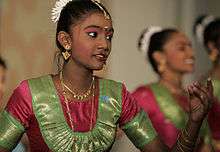Dance in Singapore
Dance in Singapore comprises traditional and contemporary forms. It has a relatively short history of creative, artistic and professional dance. The range of dance reflects the cultural diversity of Singapore.[1] There is a consistent struggle between the rejection and acceptance of western dance influences and the re-emphasis of ethnic cultures from time to time. The Singapore identity through dance is a challenging one often on an outward looking perception rather than the acceptance and recognition of indigenous/original creativity. Notable non-profit artistic dance legacy include ECNAD and Arts Fission Company.
 Life in Singapore |
|---|
Traditional styles
Singapore is a multinational country. Though its predominant ethnicity is Chinese, there are also other Asian communities, especially Indians, Malays and Indonesians.
- Chinese dances are very popular in Singapore. The Lion Dance is performed in the New Year festivities, among other dances performed in other cultural events.
- The Malay national dance, Zapin, is popular among Malays.
- Indian Bharatnatyam and, to a lesser extent, Kathak are taught in many Indian dance schools in Singapore, given fact that most Indians of Singapore are mostly Tamil in ethnicity, among other South Indians.
- Peranakan dance blends Malay and Chinese influences in both choreography and clothing. Peranakan music has Malay and Western influences.
Post-War history (in search of identity)
After World War II, Singaporeans fought for self-government and in search for a new identity, a united anti-colonial movement multi-cultural activities were initiated.
1959–1969 (the pre-professional dance years)
The economy was the main emphasis after self-government in 1959, however, a Ministry of Culture[2] was formed to encourage the preservation and development of Chinese, Malay and Indian dances. Western Modern Dance had not yet been practised in Singapore then. Western influence was then deemed to be undesirable.
National Theatre built in 1963
The Singapore government built its first National Theatre in 1963 to showcase local ethnic dance and its development. The 1st Southeast Asia Cultural Festival was held there.
1970s
The growing Singapore economy in the 1970s see the formation of its full-time People's Association Dance Company. National Dance Festival was organised in 1978.
Singapore Festival of Dance
Singapore organised its first Singapore Festival of Dance (which became the Festival of Asian Performing Arts and now evolved in the present days Singapore Arts Festival). The Festival of Dance's has an objective of creating new local dance forms through the working together of ethnic dance choreographers but this Singaporean identity did not work out very well.
Traditional dance (1980s)& setup of National Arts Council

In May 1980, the National Theatre Dance Company (NTDC) was formed by National Theatre Trust, upon the successful completion of the dance training programme conducted by prominent Hong Kong instructor, Mr. Cheng Shu Jing. The training programme had culminated in a concert, "An Evening of Chinese Dances" being performed on 24 Nov 1979. NTDC had evolved to become Theatre Arts Troupe in 1992, after National Theatre Trust amalgamated into the National Arts Council. Since then, Arts Council of Singapore has developed into one of the biggest and most ambitious arts council in the world with adequate staff strength covering all aspects of the arts in Singapore. The only problem is that there seems to be less direct funding available for dance projects over the years and company directors for dance that not adequately supported to power their training, outreach and community efforts. All of which are areas that the council has taken charge themselves. So, private initiative seems to be dying off slowly but surely.
Ballet (government initiated company)
From the early years of rejection of western influences, the government decided to embrace western performing arts in a big way namely in the setting up of a national ballet company Singapore Dance Theatre and the Singapore Symphony Orchestra.
Singapore Dance Theatre, a ballet company founded in 1988, took over NTDC as Singapore's national dance company, acquiring works of well known choreographers and housing mainly young foreign dance talents. It is a repertory company showcasing mainly classical ballet and contemporary ballet works. The late Anthony Then (artistic co-founder with Goh Soo Khim) had strong creative influences in creating his own ballet pieces in the past. His choreography was last presented in 2009 for the company's 20th Anniversary. Many of the works of Goh Choo San, a well-known Singaporean choreographer, have been presented by the company. SDT now has an established place on the arts scene and performance calendar in Singapore. There are 36 dancers in the professional company and the repertoire ranges from full-length classical ballets to newly created contemporary work.
Structured formal dance training (1990s)
In the 1990s Nanyang Academy of Fine Arts (NAFA) started Singapore's first full-time Modern Dance programme. The programme was headed by Angela Liong and offered all-rounded dance theory and technique program including Martha Graham's technique and dance improvisation. Her programme was delivered with strong contemporary arts references and education on top of the regular dance training plus many workshops through an exchange programme whereby many American dance artists have worked with the students then. The existing pioneers of contemporary dance were students from this programme.
Over the years, Dance at NAFA has grown from a fledgling start into an established and reputable department with the help of better funding availability from the government. The Department of Dance has survived and thrived largely because of the capable direction as well as vision of several committed individuals. The initiatives of these individuals, who are respected in Singapore's dance community, have eventually contributed to today's distinctive Diploma in Dance program that combines contemporary Asian and Western performance and creative practices. LaSalle is another institution that offer dance diploma programme as well as the newly set up SOTA. However, there is a lot more room for synergy between Government, Institutions and Arts Companies to build a common vision for the local dance scene. Currently, new generation of trained dancers are moving more into commercial and school projects, less are really to contribute in the artistic arena.
Currently, most of the local institution trained dancers do not work with artistic companies. They tend to go into child care, teaching in schools and taking ad-hoc commercial projects. The lack of professional artistic dancers is further worsened by this trend.
The Singapore Dance Theatre also provides a training programme for dancers and choreographers just like any of the local dance groups too.
Creative contemporary dance identity in Singapore
In general, the first generation of theatrical dance professionals have contributed mainly as dance teachers whereas the second generation produces more original choreography and performances in developing the scene.
References
- Dance in Singapore at DanSing Archived 16 February 2008 at the Wayback Machine
- MICA Resonance Archived 17 July 2011 at the Wayback Machine